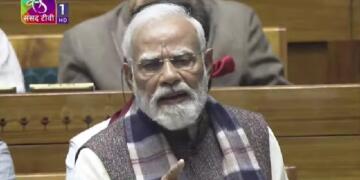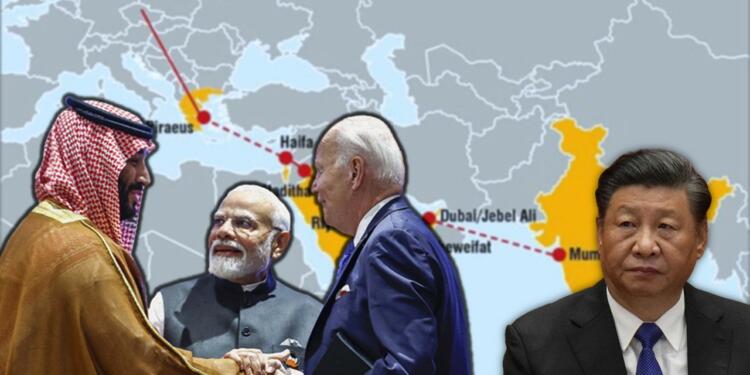“In addition to causing diplomatic and public opinion turmoil, India’s actions in hosting meetings in disputed territories have also ‘stolen the spotlight’, sabotaging the cooperative atmosphere of the G20 meeting and hindering the achievement of substantive results.”
Despite China’s decision not to attend the G20 summit or send proper representatives, it has been quick to express severe dissatisfaction and discontent when matters do not align with its preferences. This raises the question: what has rattled the Dragon so profoundly? What has India done to send shivers down China’s spine?
One plausible explanation could be the India Middle East Europe Economic Corridor (IMEEEC), a strategic initiative that could potentially mark the end of the much-touted China’s Belt and Road Initiative (BRI).
Welcome aboard, and today we shall know more about the India Middle East Economic Corridor, exploring the implications of India’s actions and the potential consequences for the Chinese hegemony over the global trade.
What is India Middle East Europe Economic Corridor?
Recently, leaders from Bharat, Saudi Arabia, UAE, France, Germany, Italy, the United States, and the European Union (EU) have unveiled a memorandum of understanding (MOU) for the establishment of the India-Middle East-Europe Economic Corridor (IMEC) at the recently concluded G20 summit. This initiative aims to unlock the economic potential of the region and promote global infrastructure development.
During the announcement, President Biden expressed his pride in finalizing this historic agreement, highlighting the IMEC’s significance. The corridor will involve substantial investments in ships and railways, connecting India to Europe via the UAE, Saudi Arabia, Jordan, and Israel.
Notably, the IMEC has garnered support from several influential entities beyond India and the United States, including the European Union, France, Germany, Japan, Italy, Mauritius, and the World Bank. It is perceived as a robust response to China’s Belt and Road Initiative, signifying its global importance.
Also read: G20 Summit: What India actually achieved
Crown Prince and Prime Minister of Saudi Arabia, Mohammed bin Salman bin Abdulaziz Al Saud, pledged a substantial contribution of $20 billion to the project, underlining the strong commitment of participating nations to this endeavor.
The IMEC comprises two major corridors: an Eastern Corridor linking Bharat to the Gulf region and a Northern Corridor connecting the Gulf region to Europe. It encompasses a comprehensive network involving railways, ship-rail transit, and road transport routes. This multi-dimensional approach aims to enhance connectivity and facilitate infrastructure development throughout the India-Middle East-Europe axis.
The announcement took place during a special event on Partnership for Global Infrastructure and Investment (PGII) and India-Middle East-Europe Economic Corridor (IMEC) on September 9, 2023, held alongside the G20 Summit in New Delhi. The event’s primary objective was to foster greater investment in infrastructure and strengthen connectivity across the Bharat-Middle East-Europe region. The IMEC’s unveiling marks a significant step forward in global efforts to boost economic cooperation, connectivity, and development in this strategic corridor.
Why is it beneficial?
In the words of Israeli PM Benjamin Netanyahu, “Israel is at the focus of an unprecedented international project that will link infrastructure from Asia to Europe. This link will also realise a multi-year vision that will change the face of the Middle East, and Israel, and will affect the entire world. This vision starts in India, passes through the United Arab Emirates (UAE), Saudi Arabia, Jordan and Israel before reaching Europe.”
This statement is enough to describe the umpteen benefits that the proposed IMEEC Corridor will have for every beneficiary concerned. One of the primary advantages of the IMEC is its potential to serve as an effective substitute for China’s Belt and Road Initiative (BRI).
The BRI has faced scrutiny, particularly regarding debt sustainability issues, especially among smaller nations. The IMEC, by contrast, offers a fresh approach to infrastructure development and connectivity, potentially mitigating some of the concerns associated with the BRI.
For Bharat, the benefits are multifaceted. Firstly, it provides an alternative trade route that is less susceptible to potential disruptions and interference, a significant advantage in the current geopolitical landscape. This alternative route can diversify Bharat’s trade options, reducing dependence on existing routes and fostering economic resilience.
Furthermore, the IMEC is expected to draw the interest of additional Asian nations, further strengthening manufacturing, food security, and supply chains within its sphere of influence. The corridor’s structure, consisting of both an eastern corridor linking Bharat to the Arabian Gulf and a northern corridor connecting the Arabian Gulf to Europe, offers a comprehensive framework for regional economic integration and cooperation.
Bharat’s recent export performance, exceeding $800 billion during the first half of 2023, is a testament to its economic potential. Despite modest declines in merchandise exports, Bharat remains a significant player in global trade. The IMEC could significantly bolster Bharat’s export capabilities, creating additional revenue streams and strengthening its position in the global market.
Moreover, Bharat’s space achievements, exemplified by the success of Chandrayaan 3, open up new opportunities. These successes could potentially contribute to Bharat’s burgeoning service exports, further diversifying its revenue streams and possibly propelling it towards the coveted milestone of $400 billion in service exports.
Also read: What is Xi Jinping so afraid of?
Why is China losing sleep?
While China has not explicitly commented on the proposed corridor, the timing of the statement and the corridor’s unveiling has sparked curiosity. So, why is China showing concern when it seemingly has a firm grip on global trade? Several factors shed light on this:
- Corpus Fund and Debt Conditions:
One key distinction lies in the financial approach. The IMEC envisions a corpus fund of $600 billion, financed by the Global Infrastructure and Investment (PGII). Importantly, it avoids imposing stringent financial conditions like those associated with China’s BRI, which often lead to concerns about debt traps for beneficiary countries. This absence of crypto conditions enhances the attractiveness of the IMEC as a sustainable and equitable economic initiative.
- Focus on Regional Cooperation and Environmental Benefits:
Another notable difference is the emphasis on regional cooperation and environmental considerations within the IMEC. This focus on sustainable development and ecological safeguards is a marked departure from China’s BRI, where such considerations have been less prominent. The IMEC aims to foster cooperation and promote environmentally responsible infrastructure development.
- BRI Erosion:
China’s BRI is also facing challenges on another front. Italy, a crucial member of the initiative, has decided to disengage from the project. This development, influenced by political changes in Italy, hints at potential shifts within the BRI. If such departures continue, it could weaken the initiative’s global reach. Over time, only a few countries, such as Pakistan and Turkey, might remain part of the BRI, rendering it less potent.
- China’s Economic Challenges:
China’s economy has encountered significant headwinds recently, experiencing notable declines in both imports and exports. This economic fragility, coupled with mounting debt and other economic concerns, makes the proposed IMEEC Corridor a source of apprehension for China.
To sum it up, the proposed India-Middle East-Europe Economic Corridor holds immense promise for Bharat and the participating nations, offering an alternative trade route, promoting clean energy, enhancing infrastructure connectivity, and potentially boosting economic growth. This initiative not only strengthens regional cooperation but also has the potential to reshape global trade dynamics and contribute to the economic well-being of the nations involved. Also, it shall strike down the hegemony of Chinese economy over global trade for once and for all.
Support TFI:
Support us to strengthen the ‘Right’ ideology of cultural nationalism by purchasing the best quality garments from TFI-STORE.COM




























